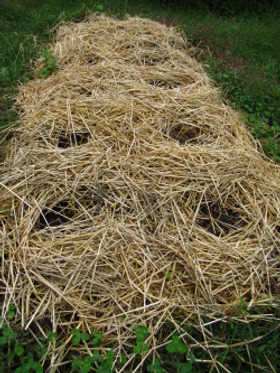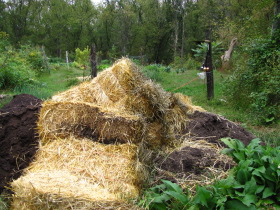
Straw bale garden mulch update
 Our truckload
of straw bales is going to good use as a premium mulch for this
year's garlic crop.
Our truckload
of straw bales is going to good use as a premium mulch for this
year's garlic crop.
I'm thinking we might go for
another load so that the other beds don't get too jealous and everybody
feels tucked in for the winter.

Want more in-depth information? Browse through our books.
Or explore more posts by date or by subject.
About us: Anna Hess and Mark Hamilton spent over a decade living self-sufficiently in the mountains of Virginia before moving north to start over from scratch in the foothills of Ohio. They've experimented with permaculture, no-till gardening, trailersteading, home-based microbusinesses and much more, writing about their adventures in both blogs and books.
Want to be notified when new comments are posted on this page? Click on the RSS button after you add a comment to subscribe to the comment feed, or simply check the box beside "email replies to me" while writing your comment.

Our most productive variety is Silverwhite Silverskin, which keeps very well, but has relatively small cloves. Music makes huge heads from huge cloves, but since each head only has four to six cloves, it produces less garlic per clove planted (if that makes sense). We also plant a bit of Italian Softneck, which is halfway between the other two in productivity.
The big distinction is softneck or hardneck. Silverwhite Silverskin is a classic example of softneck --- store-sized heads that keep forever; productive plants that need no care except weeding. Music is an example of hardneck garlic --- huge heads that don't keep very long; the plants produce a scape that has to be broken off to promote bulb formation.
Hey guys, be careful using hay as mulch; it does not matter if the bales are 3 to five years old in most cases but if you are using new hay you could have a garden of nice weeds next year. The same goes for any compost that is added to the garden. I was given a truck load of fresh horse manure, my garden exploded but so did some weeds that I have yet to identify. Keep up the great work, love reading all that you are doing. oneoldchief
Thanks for sharing your experience! There's actually a big difference between hay and straw. The former is cut from a field of (often wild) grasses, usually when there are seed heads on the grass, so it's chock full of seeds. I only recommend using hay after it has been thoroughly composted to kill the weeds, or as a bottom layer of a kill mulch where the top layers prevent the weeds from germinating.
Straw is a different kind of product, produced when wheat or other grains are harvested and threshed. The only seeds you should have in a bale of straw are a few leftover grain seeds --- these sprout into hefty grasses and can be quickly pulled.
If you're not sure of the difference, fresh straw tends to be yellowish (and always has big stems), while hay tends to be brownish, even with a hint of green sometimes, and to have small stems.